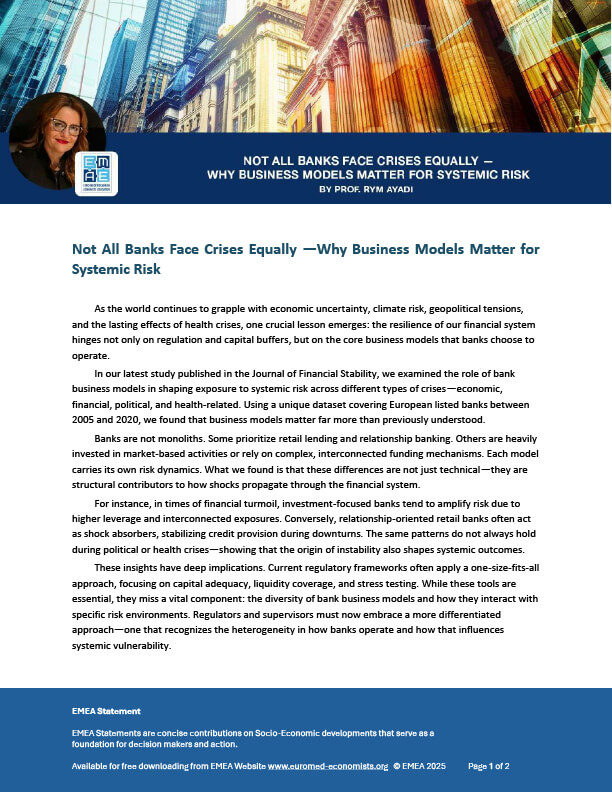By Prof. Rym Ayadi
The 21st-century challenges of climate change, social inequities, and geopolitical volatility necessitate innovative governance frameworks. Data-driven tools like nature and brain capital dashboards can play a transformative role in shaping systemic investment strategies, particularly within the Environmental, Social, and Governance (ESG) paradigm. These dashboards provide actionable insights to bridge sustainability, resilience, and human capital development.
Nature capital represents ecosystems, biodiversity, and natural resources that underpin economic activities and societal well-being. Incorporating nature capital into governance ensures investments account for long-term environmental resilience and ecosystem services.
Key metrics are available such as Biodiversity indices, carbon sequestration potential, water and soil quality, and economic benefits from nature-based solutions.
All relevant for ESG, Nature-positive metrics strengthen the “E” pillar, promoting sustainable resource use and mitigating climate risks.
In addition, Brain capital (put forward by the Brain Capital Alliance) focuses on the cognitive and emotional resources of individuals, emphasizing brain health, education, creativity, and adaptability as drivers of innovation and productivity.
The key metrics, such as Cognitive health data, education outcomes, mental health indices, innovation capacity, and neurodiversity inclusion.
All key to ESG, Brain capital enriches the “S” and “G” pillars by enhancing social well-being and governance through informed decision-making and future-ready skills.
Building and Operationalizing Nature and Brain Capital Dashboards is essential and the action missing that must be put forward immediately with no delay
The Dashboards must feature integrated Metrics Combining environmental, cognitive, and socio-economic data to reflect interdependencies becomes essential through leveraging AI and IoT for real-time data collection and scenario modeling and highlighting the outcomes of ESG-aligned policies and investments on nature and brain capital.
The Nature Capital Dashboard Components include: Ecosystem service mapping, Biodiversity loss risk assessments and Climate resilience scores
The Brain Capital Dashboard Components include: Workforce cognitive readiness assessments, Mental health impact trackers, Innovation potential indices
The integration into ESG Strategy is possible through the use of dashboards to benchmark ESG performance, and the development of thematic funds focusing on brain and nature-positive sectors (e.g., green tech, mental health innovation). Moreover one must align portfolio goals with Sustainable Development Goals (SDGs) and Paris Agreement targets.
The connection to Systemic Investment Strategies is to link to ESG Principles
- Environmental Pillar: Promote regenerative agriculture, renewable energy, and conservation through nature capital metrics.
- Social Pillar:Address workforce mental health and education gaps via brain capital insights.
- Governance Pillar: Foster transparency and accountability using dashboards to monitor and report ESG performance.
Innovative Investment Approaches include
- Blended Finance that combines public and private capital to fund nature-based and brain health initiatives.
- Green and Brain Bonds: which are issued bonds tied to ecosystem restoration and brain health improvement targets.
- Impact Investing that focuses on startups and projects delivering measurable brain and nature-positive outcomes.
There are challenges and Opportunities to this systematic approach.
- The challenges include:
- Data standardization across sectors.
- Addressing privacy and ethical concerns in brain data collection.
- Navigating trade-offs between short-term returns and long-term systemic benefits.
Opportunities are numerous and include
- Collaboration between governments, financial institutions, and academia to refine dashboards.
- Policy incentives for nature and brain-positive investments.
- Enhanced investor confidence through data transparency and accountability.
To conclude, governance frameworks for the 21st century must embrace holistic, data-driven approaches to tackle systemic challenges. Integrating nature and brain capital dashboards into ESG strategies offers a unique opportunity to align economic growth with sustainability and resilience. By leveraging these innovative tools, investors and policymakers can drive transformative change, fostering a future that values both human potential and environmental stewardship.
Link to the Global Brain Capital Dashboard
The article is based on Prof. Ayadi’s intervention at COP29 side event “Data for 21st century governance”. The event was organised by the UN Climate Change Global Innovation Hub in collaboration with the RISE Research Institutes of Sweden and the Net-Zero Compatible Innovations Initiative. The session discussed on how to deliver the innovations needed (economic, cultural, structural, technical, etc.) for a flourishing future.
More info and the video of the event “Data for 21st century governance” is available at this link





